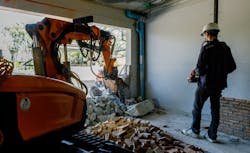How Technology Could Combat a Construction Labor Shortage
In a season of economic recovery post-pandemic, an ongoing labor shortage is hurting small businesses and entire industries alike, but workforce technology may offer a quick solution, according to Forbes. Though the real estate industry makes up 18% of the U.S. economy, an additional 1 million more construction workers and skilled tradespeople are needed to keep homes on the market and to cut down national inflation after home price gains of 18.6% over the past 12 months.
As the scarcity of qualified candidates leaves worksites shorthanded, construction technology could take on the roles of unfilled positions, leading to safer work environments and greater cost savings. Even simple solutions for consolidating workforce data from spreadsheets to hands-off tech platforms can save time and money.
“As we make the rate of tech adoption across real estate more like the pace of advancement within consumer electronics, there will be substantial impacts across the economy,” said Mitchell Schear, executive partner at Camber Creek, the venture capital firm that recently co-led the Series B round for Bridgit.
“This will lead to cost savings in housing, safer construction worksites and more environmentally friendly buildings.”
